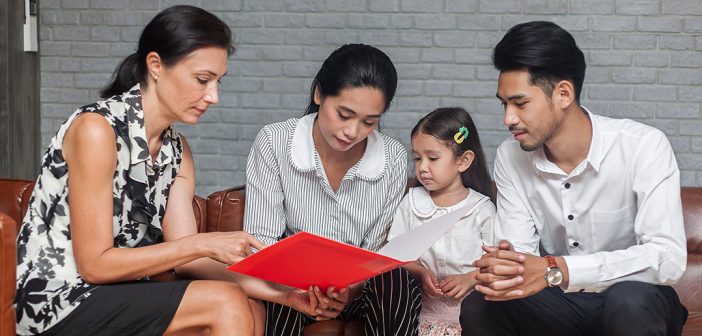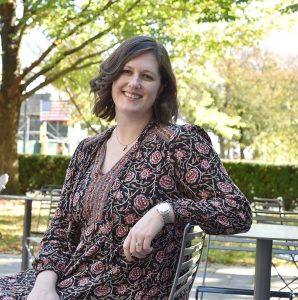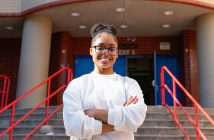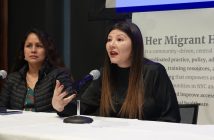Remote learning was tough for most students, but it was especially hard on the youngest ones, as any parent who tried to guide a 5-year-old through Zoom-based kindergarten can attest.
But for Annie George-Puskar, Ph.D., an assistant professor of curriculum and teaching at the Graduate School of Education (GSE), there was a silver lining to the way education was conducted during the pandemic. It brought into sharp relief the ways that teachers can work with caregivers to help students transition into new learning environments.
Listening to Early-Childhood Educators
Those teacher-caregiver relationships are the focus George-Puskar’s study, “Early Childhood Educators’ Perspectives on Child & Family Transitions into Preschool in NYC,” which was published on May 17 by the NYC Early Childhood Research Network.
It was almost a very different study. With a grant from the GSE dean’s office and the Early Childhood Research Network, George-Puskar had been set to study the ways special education students made the transition into preschool. But the onset of the COVID-19 pandemic in March 2020 and the shift to online learning forced her to change her research.
“The pandemic really shifted my focus to teacher-parent relationships rather than teacher-child relationships,” said George-Puskar.
“We talk so much about child readiness in terms of academic and social skills, and self-help skills, but how are you really gauging if parents are ready to send their kids to school? And how can you work with parents to communicate more effectively as you support them and caregivers in this transition?”
George-Puskar had already specialized in the transitions that students make as they enter pre-school when she joined GSE in 2019. It was a particularly timely area of study, as New York City had launched its “3-K for all” pre-k program five years earlier.
For this study, she worked with the New York City Department of Education’s division of early childhood education and early childhood professionals from private schools to embark on a survey that was not just limited to special education. The questions focused on what technologies teachers used during the pandemic to communicate with parents, and how they affected the transition into preschool.
Examples of the questions in the survey included: “Thinking about the transition into your classroom, how do you know a transition is successful for a child and family?” as well as “What are the biggest challenges to successful transitions into your classroom/program?” and “Thinking about the experience from last year to what you did this year around the transition, what is the biggest difference?”
In all, she and her study co-author Jill Gandhi, Ph.D., received 327 responses from schools from all five boroughs. Researchers also spoke with 20 respondents in follow-up interviews.
Effective Communication with Caregivers
“One of the things that we asked quite a bit about is the amount and type of communication that happened prior to a child starting on the first day,” George-Puskar said.
The biggest barrier to reaching families is ineffective communication, she said, so one of the best practices recommended is using communication technology they learned to use during the pandemic.
“The teachers who had had professional development [about 45%]were really creative in how they used technology in the classroom to really make the child and the family feel welcome and prepared for the start of the school year.”
Whereas these teachers did things like send newsletters and emails and invited children and families to in-person or virtual classroom tours, those who hadn’t received training tended to only reach out to parents when there was a problem.
“Only making calls when something’s wrong is not a great way to collaborate with parents, or make them feel good about what’s going on in the classroom,” she said.
“So, using those communicative and collaborative practices to establish a rapport with families is what we need to focus on for those teachers.”
George-Puskar became interested in working with children with disabilities when she was an undergraduate and even wrote her master’s thesis on how kids on the autism spectrum learn through different levels of play. Working with the family of a boy who was diagnosed with autism at three years old, she saw the stressors that are placed on parents as they navigate education and service systems.
“I also realized that I study transitions because I don’t like them,” she said laughing.
“I have a hard time with transitions, so it’s a helpful outlet for me to say, ‘How can we make this easier on parents and caregivers, including myself?”
Developing Leaders at All Levels
In addition to transitions and play-based learning, George-Puskar studies leadership development in early childhood special education. Last September, she co-hosted a panel workshop at the Division for Early Childhood & International Society of Early Intervention joint conference in Chicago.
Her goal is to take lessons about leadership from the business world and organizational psychology and apply them to education.
“When we talk about educational leaders, it kind of equates to administrative leaders and school building leaders,” she said.
“But I really want to emphasize how you can develop leaders at all levels, as teachers and assistant teachers in the classroom, and as students preparing to become teachers. You don’t have to have a title to be a good leader.”




